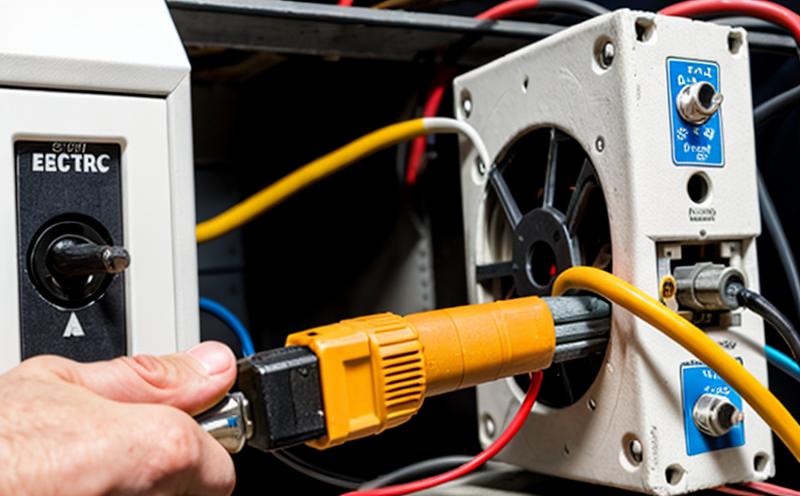EN 61000-6-4 EMC Emission Test for Industrial Equipment
The EN 61000-6-4 standard defines limits and methods for electromagnetic compatibility (EMC) emissions in industrial environments. This standard is crucial for ensuring that electrical equipment does not emit excessive levels of radio frequency interference, which can disrupt the operation of other electronic devices.
Electromagnetic emissions from industrial equipment are a significant concern due to their potential impact on both human health and the reliability of critical systems within facilities. The testing outlined in EN 61000-6-4 is designed to identify and mitigate these issues by providing a structured approach to measuring and controlling emissions.
The test involves exposing the industrial equipment under test (IUT) to controlled electromagnetic environments, typically including both conducted and radiated emission tests. Conducted emissions are measured using differential impedance measurement techniques at various frequencies, while radiated emissions are assessed through spatial field measurements or antenna-based systems.
Preparation of the IUT for testing is critical. This includes ensuring that all external connections are properly terminated, and that any internal components known to contribute significantly to emissions are identified. The IUT must also be configured in its intended operational state, allowing accurate measurement of real-world performance.
The test setup typically involves a Faraday cage or anechoic chamber designed to prevent interference from external electromagnetic sources. Specialized equipment such as spectrum analyzers and antennas are used to capture emissions data across the frequency range specified by EN 61000-6-4. Compliance with this standard ensures that the IUT does not exceed established emission limits, thereby protecting nearby electronic devices and workers.
Compliance testing is often required before equipment can be sold or deployed in certain markets, particularly those adhering to European Union directives. For industrial applications, such as motors, drives, and control systems, this test is essential for ensuring interoperability and avoiding potential interference issues.
The importance of EN 61000-6-4 testing extends beyond mere compliance; it also enhances the overall quality and reliability of equipment in complex industrial settings. By minimizing electromagnetic interference (EMI), these tests contribute to safer working environments, more efficient system operation, and reduced maintenance costs.
In summary, EN 61000-6-4 is a vital standard for ensuring that industrial equipment operates safely within its environment without causing harmful electromagnetic emissions. Compliance with this test not only meets regulatory requirements but also promotes better performance and longevity of the equipment in demanding operational conditions.
Why It Matters
The significance of EN 61000-6-4 testing cannot be overstated, particularly for industrial equipment. Emissions from electrical devices can interfere with other sensitive electronics, leading to malfunctions or complete system failures. In critical environments such as hospitals and data centers, such interference could have severe consequences.
The standard's focus on conducted and radiated emissions ensures that equipment operates within safe limits, minimizing the risk of disruption to other systems. This is especially important in industries where precision and reliability are paramount, such as manufacturing, transportation, and energy production.
By adhering to EN 61000-6-4, manufacturers can ensure their products meet international standards, enhancing marketability and reducing the likelihood of recalls or product liability issues. Additionally, compliance with this standard demonstrates a commitment to safety and quality, which is increasingly valued by consumers and regulatory bodies.
Furthermore, the test results provide valuable insights into the performance characteristics of industrial equipment under real-world conditions, enabling continuous improvement in design and manufacturing processes. This proactive approach to quality control contributes significantly to the overall reliability and longevity of industrial systems.
Benefits
The benefits of undergoing EN 61000-6-4 EMC emission testing are manifold, offering substantial advantages across various aspects of industrial operations. Compliance with this standard ensures that equipment operates safely within its designated electromagnetic environment, reducing the risk of interference with other systems.
By minimizing emissions, manufacturers can enhance the overall performance and reliability of their products, leading to fewer operational disruptions and lower maintenance costs. This is particularly beneficial in high-reliability applications where downtime is costly or unacceptable.
The test results also serve as a powerful marketing tool, allowing companies to differentiate their products by highlighting compliance with international standards. This can be especially advantageous for businesses targeting markets that have stringent regulatory requirements.
Moreover, EN 61000-6-4 testing provides valuable data on the performance characteristics of industrial equipment under real-world conditions. This information is invaluable for R&D teams looking to refine and improve product designs, ensuring they meet or exceed industry expectations.
In summary, the benefits of this test extend beyond mere compliance; it contributes significantly to operational efficiency, safety, and market competitiveness in the industrial sector.
Why Choose This Test
Selecting EN 61000-6-4 EMC emission testing for your industrial equipment is a strategic decision that can yield numerous advantages. The test ensures that your products meet international standards, enhancing marketability and reducing the risk of regulatory non-compliance.
By adhering to this standard, you demonstrate a commitment to quality and safety, which is increasingly valued by consumers and regulators alike. This can lead to improved brand reputation and customer trust, fostering long-term relationships with partners and clients.
The test also provides valuable insights into the performance characteristics of your equipment under real-world conditions. This data can be used to refine product designs, improve manufacturing processes, and enhance overall reliability. Such continuous improvements contribute to better-performing products that are more resilient in challenging operational environments.
In addition, EN 61000-6-4 testing helps mitigate the risk of electromagnetic interference (EMI) affecting other electronic devices within industrial settings. This is particularly important for maintaining system integrity and preventing potential disruptions or failures in critical operations.
The test results can be used to identify areas where further optimization is needed, allowing for targeted improvements that enhance both performance and cost-effectiveness. By investing in this testing, you are taking a proactive approach to quality control, ensuring that your products meet the highest standards of reliability and safety.





